Asked to describe the average greenhouse, many readers might picture a mainly glass structure. There is, however, an alternative which offers even greater growing potential across the seasons with far less energy consumption: the solar greenhouse. Particularly popular in China since the late 1970s, solar greenhouses make use of passive solar energy to retain the maximum possible amount of heat.
So what’s the issue with the typical garden greenhouse? Whilst it has many advantages in the summer months, for anyone growing out of season a glass greenhouse realistically involves the input of a great deal of extra energy. According to Kris de Decker of Low-Tech Magazine ‘that’s because each square metre of glass, even if it’s triple glazed, loses ten times as much heat as a wall.” In commercial settings, high yields come at the cost of artificially heating large and often less than optimally airtight structures.

By way of solution, the design of a solar greenhouse incorporates solid walls of a suitable material. As Michael Bomford of Energy Farms explains ‘the Chinese greenhouse design is simple. A thick wall and partial roof on the north side act as heat sinks to absorb solar energy during the day and radiate it back into the house at night. Arched struts extend from the peak of the roof to the soil surface, up to 12m south of the north wall. These are clad in a single layer of plastic. An insulating blanket rolls down over the plastic at night to retain heat.” The solid walls are generally formed of brick or clay and the insulating blanket could be fashioned from straw, dried grass or canvas, alongside other modern insulative materials.
Whilst it is true that in the colder climate of the UK and other northern countries some additional heating would be required in the depths of winter, a solar greenhouse still represents a significant saving in comparison to the standard glass equivalent. There are, however, some drawbacks, the first of which relates to space and yield when compared to a glass greenhouse. Drawing on recent research (here and here), Kris states that:
“The passive greenhouse could save a lot of energy, but a price would have to be paid: the profits generated by the Chinese greenhouse are two to three times lower per square meter than those of its fully glazed counterpart. In the more efficient Chinese greenhouses, an average 30 kg of tomatoes and 30 kg of cucumbers can be grown per square meter (numbers from 2005), while the average production in a glass greenhouses is about 60 kg of tomatoes and 100 kg cucumbers (numbers from 2003). A passive greenhouse industry would thus take up two to three times as much space to produce the same amount of food. This could be viewed as a problem, but of course what really eats space in agriculture is meat production. A more diverse and attractive supply of vegetables and fruits could make it more viable to reduce meat consumption, so land use shouldn’t be a problem.”
The second is one common to both types of greenhouse: that of the lack of a CO2 source. According to Kris, in modern-day commercial greenhouses “operators aim to have a CO2-level at least three times the level outdoors to increase crop yield. This CO2 is produced as a byproduct of the fossil fuel based heating systems inside the greenhouses. However, when no fossil fuels are used, another source of CO2 has to be found.” Cue the manure!
Many Chinese growers will typically combine growing produce with rearing animals. “Pigs, chickens, and fish all produce CO2 that can be absorbed by the plants, while the plants produce oxygen (and green waste) for the animals. The animals and their manure also contribute to the heating of the structure. Research of such integrated greenhouse systems has shown that the combined production of vegetables, meat, milk, and eggs raises yields quite substantially.” Meanwhile American Justin Walker is pioneering an integrated system using a combination of horses, goats and sheep in a Siberian monastery, as featured in this book. The structure is partly underground to mitigate against the particularly harsh climate, whilst above ground are earth-bermed. A hayloft above the barn provides extra insulation in the winter when full and ventilation in the summer when empty. His compost heat recovery system produces hot water that is piped through radiant floor heating zones in the floor of the greenhouse. The CO2 is supplied by the animal manure.

For those of us without livestock, however, the manure alone will of course suffice and compost-heating is certainly viable with an adequately insulated greenhouse, particularly those with the added benefit of a passive solar design. It has the added bonus too of increasing soil fertility at the same time. In summary, then, whilst it may not be time to ditch the glass garden greenhouse for most of us just yet, for serious growers with suitable space the passive solar greenhouse could well be worth a try as a low-impact and less energy consuming alternative – particularly where manure is readily available!
You can find further information about greenhouses in general in our topic introduction. For more about passive solar greenhouse design, see the original article on the Low-Tech Magazine website, with excerpts reproduced above with kind permission from Kris de Decker.

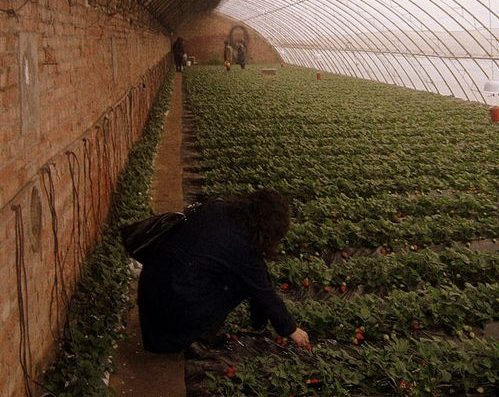
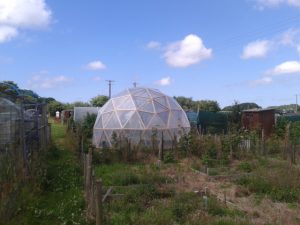
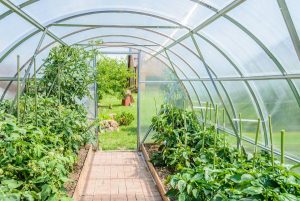
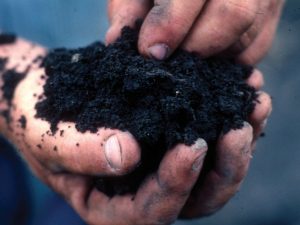
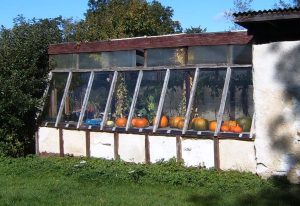
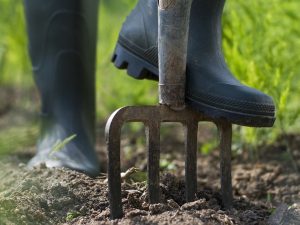
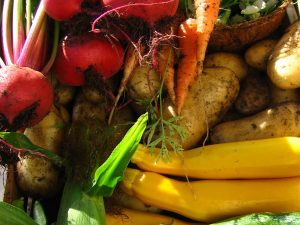
7 Comments
What an interesting article.
Having toured a number of UK commercial greenhouses producing salad crops I can see why this passive solar greenhouse isn’t used here. They make a lot of sense from an environmental point of view but the economics of the west are different.
The agri-business here works in a relatively high wage economy. Even the eastern European seasonal workers are expensive compared with Chinese labour.
The Western systems are generally high-input, computer-controlled hydroponics monoculture rather than having access to compostable materials such as animal manure that comes with mixed farming set-ups and growing in soil.
It’s a prime example of the conflict between environmental efficiency / sustainability with economic efficiency in a system that treats the planet as an inexhaustible resource.
Yes – I do think there’s a huge potential to move towards locally-produced, organic food from mixed smallholdings in the West though. People want that kind of food, and I’ve spoken to the most surprising people, from builders to bankers, who would rather be smallholders. It’ll be a slog, but I think it can happen.
I totally agree. It can happen and should happen. What would really help is flexibility in planning laws to allow people to move back into the countryside and for the current subsidy system with its emphasis on large farms to change to supporting small-scale farms and part-time enterprises. I’d also like to see land prices reduced to make it affordable to people.
Don’t believe the propaganda that large agri-business is the only way to supply food realistically. Fact is that smaller the area the more productive it tends to be. A garden plot or allotment will produce far more food per square metre than a farm. A small farm is more effective than a large farm.
Amen. I’m voting for you.
A National Geographic article about the latest developments in greenhouse technology in the Netherlands is interesting too. Inputs of virtually everything have been radically reduced and yields increased greatly and not even using any genetically modified plants because people in Europe won’t eat the produce. Cutting edge LED lighting is used, no soil is involved and crops like tomatoes which normally use huge amounts of water are grown using only the water collected off the roof. Biological controls are used to deal with pests and some growers keep their own hives of bees for pollination which has been shown to be cheaper than artificial pollination methods. Many of the companies involved are small although the greenhouses look vast. The Netherlands doesn’t have a single one of the things that normally make for successful food production.Tiny and very expensive land area, high wage costs, not very good weather and poor soils. What they have got is ingenuity. Using these technologies, food can be produced close to where people live which reduces energy waste and emissions.
One small clarification: The tomatoes may only utilise water from the roof but they are grown in a nutrient solution produced by adding chemicals to that water.
I agree John. The Dutch say that they are reducing the quantities of all inputs but it’s a system that depends on advanced industrial technologies requiring large chemical works and all the problems and risks that come with them.